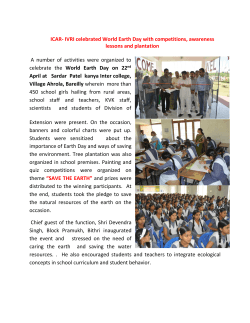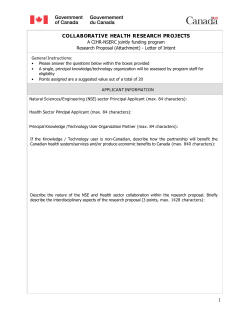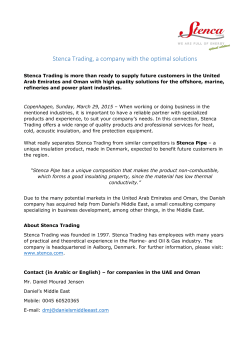
C. No. 11 / Resume No. 2 / 2015-16 To : Members of the Committee
C. No. 11 / Resume No. 2 / 2015-16 To : Members of the Committee All Members Re : Proceedings of Meeting Dear Sir, The 4th Session of the SME Knowledge Initiative was held with National Stock Exchange of India Ltd. on 22 April 2015 at the Chamber. The Brief Proceedings of the Session is enclosed for your kind perusal. Thanking you, Encl: Attached below Yours faithfully, Tuli Sengupta Roy (Assistant Secretary) Brief Proceedings of the 4th Session of ‘SME KNOWLEDGE INITIATIVE’ which was held on 22 April 2015 at the Chamber. The 4th Session of the ‘SME KNOWLEDGE INITIATIVE was held with National Stock Exchange of India Ltd. on 22 April 2015 at the Chamber. Shri Dipan Mitra, Assistant Manager, SME and Shri Kunal Dalmiya, Assistant Manager, Currency of National Stock Exchange of India Ltd. and Shri Ajay Laddha, Vice President, Sumedha Fiscal Services Ltd. were the Speakers. Shri Rishabh Kothari, Chairman, Standing Committee on MSMEs, MCCI highlighted on the need for access to bankfunding for all Startups and SMEs including technology and Service Industries and opined that Stock market for startups and SMEs was still in concept stage pending implementation. Shri Mitra made a Presentation on EMERGE – a SME platform launched by NSE Ltd. in 2012 to provide new options for raising capital by emerging companies. EMERGE symbolises the aspirations of a large number of entrepreneurs participating in the “India growth Story” and having potential to unlock value and emerge on a bigger stage. Highlights of his presentation include : • Need for capital centers around ‘Sustainable Growth’, ‘Innovation’, ‘Expansion’, ‘Diversification’ and ‘Acquisition’. • EMERGE is a separate segment in NSE regulated by SEBI which has same trading members and merchant bankers as main exchange and same trading terminals as main board. • For being an Issuer it requires 3 year operational history and 2 year positive cash accruals. Issuer’s Post issue paid up capital is Rs 10-25 crore for SME/ main Board and less than Rs 10 crore for SME Board only. • According to Shri Mitra, Listing on EMERGE-ITP has the following advantages – Higher visibility & credibility, Lesser dilution, ESOPS - to attract and retain talent and M&A, Setting the stage by getting used to compliance requirements and setting the stage for a fund raising in future. Also, Migration from SME to Main board and Main board to SME are allowed subject to conditions. • EMERGE-ITP is only for listing of securities – there shall be no public offer for raising capital. • Exit from ITP can be in any of the following routes (other than disciplinary action): Voluntary (Special Resolution and SE Approval) or Growth (10 yrs on ITP or Paid cap > Rs.25 cr or Revenues > Rs.300 cr or Market cap > Rs.500 cr). • Company who can List on EMERGE must has – ‘At least 1 year’s audited financial statements’, ‘Not been incorporated for more than 10 years’, ‘Revenues < Rs.100 crore in any of the previous financial years’, ‘Paid up capital < Rs.25 crore’, ‘Cleared standard hygiene factors (such as defaulter list, BIFR etc)’. Also the Company has received Funds from – ‘at least one AIF, VCF, and other approved category of investors / lenders (min Rs.50 lakh)’, ‘at least one or more 'Association of Angel Investors' (min Rs.50 lakh)’, ‘a scheduled bank for project financing or working capital (min 3 years elapsed and funds are utilised)’, ‘a registered merchant banker has undertaken due diligence and has invested (min Rs.50 lakh & lock-in for 3 years from listing)’, ‘a QIB, has invested (min Rs.50 lakh & lock-in for 3 years from listing)’ and ‘a specialized international multilateral agency or domestic agency or a public financial institution’. Shri Laddha made his presentation on Fund Raising through SME Exchange Platform. Highlights of his deliberations are : • SME fund raising passes through the following stages of development – ‘Promoters Funding’, ‘Venture Capital/Private Equity’, ‘SME IPO’ and ‘Migration to Main Board’. 1 • • • • • • • • • • • • The market capitalization of BSE SME is close to $1 billion, i.e. average market capitalization per company is approximately Rs. 100 crore. Many companies raised funds in multiples of their top line e.g. Comfort Commotrade, SRG Housing Finance, Jupitar Infomedia, Bronze Infra etc. One in three companies listed on SME exchanges has doubled from issue price. Small and Medium companies still have the mindset of ‘me rather we or Company”. This concept needs to change. It is recommended to think universal while going to public. Despite having solid growth potential, the managements of privately-held SMEs often remain wedded to the status quo and are wary of new management perspectives and fresh growth capital. Their fears on loss of control and equity continue to dominate strategic decisionmaking. Focus needs to be changed from ‘Governing to governance’, ‘Ownership to sharing’, ‘Tax savings to taxpaying’, ‘Owners to all stakeholders’. Ultimately stake holders are the most important part of any organization and they are to be paid back positively. Broadly Speaking, Focus should be on wealth creation for all. General Tax Benefits from Listing are ‘Zero long term capital gain tax/limited short term capital gain tax’, ‘Zero tax on distress business purchase’ and ‘Zero tax on fresh equity infusion’. Criteria of Listing comprise the following ‘Post Issue paid up capital - has to be less than Rs 2500 Lakh’, ‘Track record has to be more than 3 years EBDT - should be positive for at least 2 preceding years Net worth -should be positive for at least 2 preceding years BIFR(Should not be reported) Winding up petition(Should not have any such case) Regulatory / disciplinary action by any regulator - past 3 years Should not have any such case Other criteria include : Minimum number of members for Issue is stipulated at 50 Market making by merchant banker- mandatory for 3 years Underwriting - 100% (Merchant bankers to underwrite 15% in own account) The company shall mandatorily facilitate trading in demat securities and enter into an agreement with both the depositories Companies shall mandatorily have a website No change in promoters in preceding one year from the date of filling the application of listing The minimum application size in IPO in terms of no. of specified securities and trading lot size shall not be less than Rs. 1,00,000. Listing Procedure entails the following steps – Selection of Merchant Banker → Structuring of Capital and Valuations → Due Diligence and Pre-IPO preparation → Preparation of Offer document → Appointment of other intermediaries → Marketing Strategy → Filling of Offer document with Stock Exchange and Others → Issue Launch/Allocation → Listing/Post Listing Activities/Market Making. Benefits of SME Exchange over Main Board are – Lower time frame for listing, limited number of allotees, Display of offer document on website, Relaxation on post issue capital, Limited intervention by the market regulator SEBI, Ability to migrate to Main Board. Post Listing Threats and takeovers are Compliance with ‘Listing Agreement’, ‘Compliance with SEBI Insider Trading Regulations’, ‘Compliance with other SEBI Regulations and SCRA’, ‘SEBI 2 (Substantial Acquisition of Shares & Takeovers) Regulations, 2011’, ‘Creeping acquisitions and Compulsory and voluntary open offer’. During his presentation on ‘Hedging of Foreign Currency Risk through Exchange Traded Currency Derivatives’, Shri Dalmiya highlighted on the following points : • • • • • • • Benefits of Exchange Traded Currency Derivatives comprise ‘Equating with a large Corporate’, ‘Credit agnostic’, ‘Equality in pricing’, ‘Transparency’, ‘Low impact cost’, ‘High accessibility with Internet Based Trading (IBT) and ‘Availability of Futures & Options Contracts available for trading’. Participants in NSE include players in OTC, plus other liquidity providers. Participants are characterized as ‘Hedgers’, ‘Traders’ and ‘Arbitrageurs’ and comprise Banks, Trading Members, Corporates, Proprietary Traders, Foreign Portfolio Investors and Individuals. Margins and Mark to Market (MTM) equates all the participants in NSE. NSE offers the following products in the Currency Derivatives Segment (CDS) – ‘Currency Futures: Futures available for USDINR, EURINR, GBPINR & JPYINR’ , ‘Currency Options: Options available for USDINR only’ and ‘Interest Rate Futures (NSE Bond Futures II) - Futures contract on the 9-10 year on the run Government of India Security (G-Sec), presently available on 8.40% GS 2024’. Shri Dalmiya explained the Benefits of trading in NSE over OTC in regard to Participants, Liquidity, Accessibility, Credit Exposure, Transparency, Margin, Flexibility, Beneficiaries, Contract size and Delivery of Currencies. He further explained Hedging using Currency Options with examples and also discussed new regulations of NSE in Exchange Traded Currency Derivatives. Calculations of margins are made on the basis of portfolio. Margins are released back once trade is unwound or the contract matures. Forms of acceptable Collaterals include Cash, Bank Guarantees (BG), Fixed Deposits (FD), GOI Bonds, Approved Equities / Mutual Fund Units, Releasing Collaterals. Hedging at NSE takes place through the following steps – ‘Selection of a Trading Member(Broker)’→Complete KYC as per NSE Requirements→Post Margins with Brokers→Ready to Trade→Hedge from your Desk - Online WEB Based Access to the Live Trading Screen Currency Derivatives at National Stock Exchange are characterized by consistent commitment to market development, Business growth demonstrated through volumes and open interest, Consistent liquidity with low impact cost, More than 850 Trading Members(TM) and Banks registered with the Exchange NOW (NEAT on Web) online platform for execution of trades The Presentations by the Speakers were followed by extensive Q-A Session with the participants. The session thereafter ended with a hearty ‘Vote of Thanks’ offered by Shri Akhil Sonthalia, CoChairman, Standing Committee on MSMEs, MCCI. Tuli Sengupta Roy (Assistant Secretary) 3
© Copyright 2025









